Beneath the town of Wieliczka lies a labyrinth of salt wonders, an undeniable testament to the fact that in the search for world-class attractions, there’s no need to leave the beautiful land of Poland.
The Wieliczka Salt Mine is undoubtedly one of the most extraordinary landmarks on Poland’s map. Visited by nearly 2 million people from around the world each year, this place astonishes with its richness, history, and underground salt landscapes. Located near Kraków, this attraction had provided the means to sustain the entire nation since the 13th century. And though salt mining in Wieliczka is now a thing of the past, the mine remains a great treasure for the country—a cultural and natural heritage.
How were the underground salt deposits in Wieliczka discovered?
It’s impossible not to mention the long history of this place, as it is one of the oldest salt mines in the world. It all began back in the Neolithic period, although at that time, rather than extracting salt blocks, people obtained the mineral by boiling saline water in clay pots found on the earth’s surface. Between the 11th and 12th centuries, however, these salty springs began to dry up, forcing traders to dig the first well. This is how the mine Magnum Sal—the Great Salt—came into existence. The ability to extract underground brine wasn’t the only positive result of this development.
It was during the construction of one of the wells in the 13th century that a groundbreaking discovery was made—the first blocks of rock salt were found. Since salt could now be extracted through mining methods, more shafts were dug, and by the end of the Middle Ages, salt mining accounted for one-third of the country’s income. Throughout the mine’s operation, its activities continually expanded, and tourism gradually became as important to the site as salt extraction itself.
Wieliczka – A historical monument and tourist attraction
Today, the Wieliczka Salt Mine is primarily a place of great tourism and cultural significance. Rock salt extraction was completely halted in 1964, and just over 30 years later, all industrial salt production there ceased. Why was this decision made? After the “Royal Salt Mines in Wieliczka and Bochnia” were placed on the UNESCO World Heritage List, the management emphasized that preserving this unique site for future generations and making it accessible as a historical monument had become far more important than continuing production. Who knows, maybe it is only thanks to this decision that we can now explore these salt-filled undergrounds that resemble a fairy-tale land.
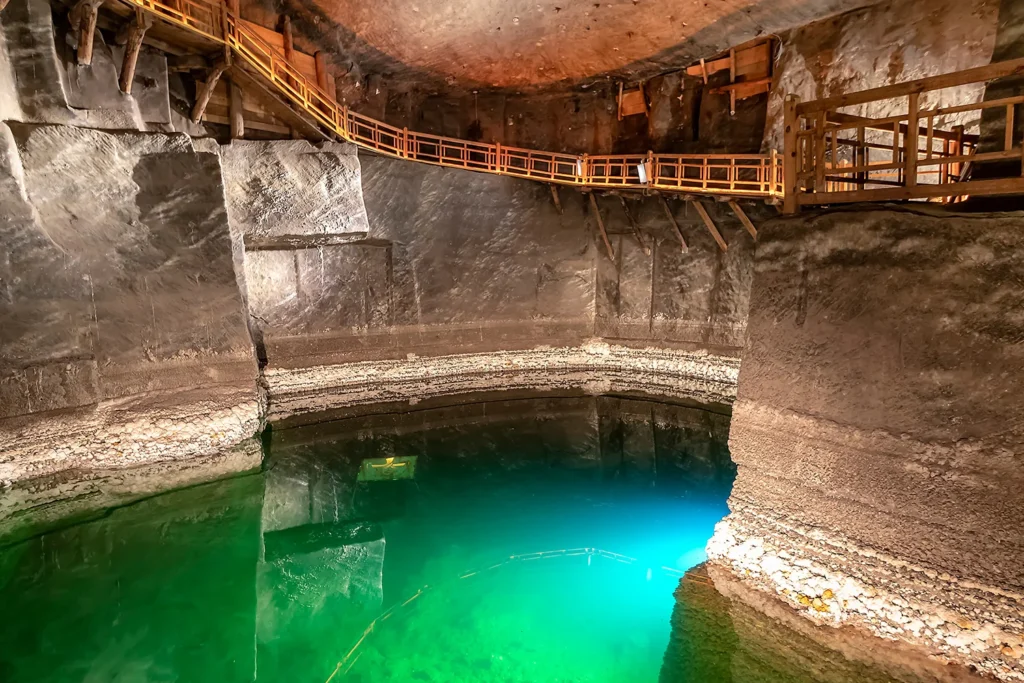
Today Wieliczka is not just a tourist attraction. It also serves as an underground rehabilitation and treatment center and a venue for important events. The cessation of salt extraction did not mean miners were left without work. Specialists continue to ensure the safety of the site, create new spaces, and conserve and restore existing chambers. Their responsibilities also include managing the harmful mining waters, with water treatment being the only remaining method of obtaining salt.
FUN FACT: Although the Wieliczka Salt Mine only became a major tourist destination in the 20th century, it had visitors long before that. It is believed that the mine’s first known visitor was none other than Nicolaus Copernicus, who toured the mine as early as 1493.
The Historic Salt Mine in Numbers
2391 chambers, 245 km of underground corridors, 9 levels, 26 mining shafts, and a maximum depth of 327 m. That is a brief summary of the Wieliczka Salt Mine after more than 700 years of use. The underground labyrinth is so vast that, even though only 2% of the area is open to tourists, walking through each of the two tourist routes takes nearly 3 hours.
The Legend of St. Kinga’s Ring
Logically, the rock salt deposits in southern Poland can be explained by the region’s geological structure, but some prefer to believe in a more magical origin of this mineral. According to legend, the salt in Wieliczka is thanks to Princess Kinga, the daughter of the Hungarian King Béla IV. When she was about to marry Bolesław the Chaste, she asked her father to give her one of Hungary’s salt mines as a dowry.
The king granted his daughter’s wish. Of course, it was impossible to take the entire mine with her. Instead, Kinga threw her engagement ring into one of the Hungarian mine’s shafts as a sign that she had taken possession of the salt deposits. Upon arriving near Kraków, the future queen instructed her miners to dig in a location she had chosen. To their surprise, they unearthed a block of rock salt, and inside it, they found Kinga’s ring—the very one she had left behind in Hungary.
Navigating the Map of Wieliczka
Descending deep underground, it would be easy to get lost in this salt labyrinth. Fortunately, with a guide, you’ll not only navigate the route with ease but also see all the natural wonders waiting for you along the way. On the several-kilometer trail, you’ll encounter underground chapels, salt formations, brine lakes, and up to 20 chambers adorned with natural salt efflorescence shaped like cauliflowers or noodles. What else surprises visitors in the depths of Wieliczka?
Stanisław Staszic Chamber
The Stanisław Staszic Chamber is proudly adorned with a bust of this Polish writer, who was also, as few know, a pioneer in the industrial use of minerals. However, what brings fame to this place are primarily its dimensions. The chamber, reaching a height of 36 meters, can be viewed either from its base or from a viewing terrace suspended 25 meters up. But that’s not all—what surprises visitors most are the extraordinary events held there. Although it sounds incredible, it was in the Stanisław Staszic Chamber that an underground bungee jump took place, along with the first underground hot air balloon flight, which earned a place in the Guinness World Records.
Pieskowa Skała Chamber
This chamber, carved out in 1669, is named in honor of Jan Wielopolski, a former mine administrator and owner of Pieskowa Skała Castle near Kraków. On the lower surface of the rock layer, known as the chamber floor, fragments of old salt stairs have been preserved to this day, and in the Kunegunda Cross-Cut, you can still see the gutters once used to drain water from the mine. In another part of the chamber, you will also find distinctive dwarf sculptures and a reconstruction of a device that was used for the vertical transport of salt.
Copernicus Chamber and Weimar Chamber
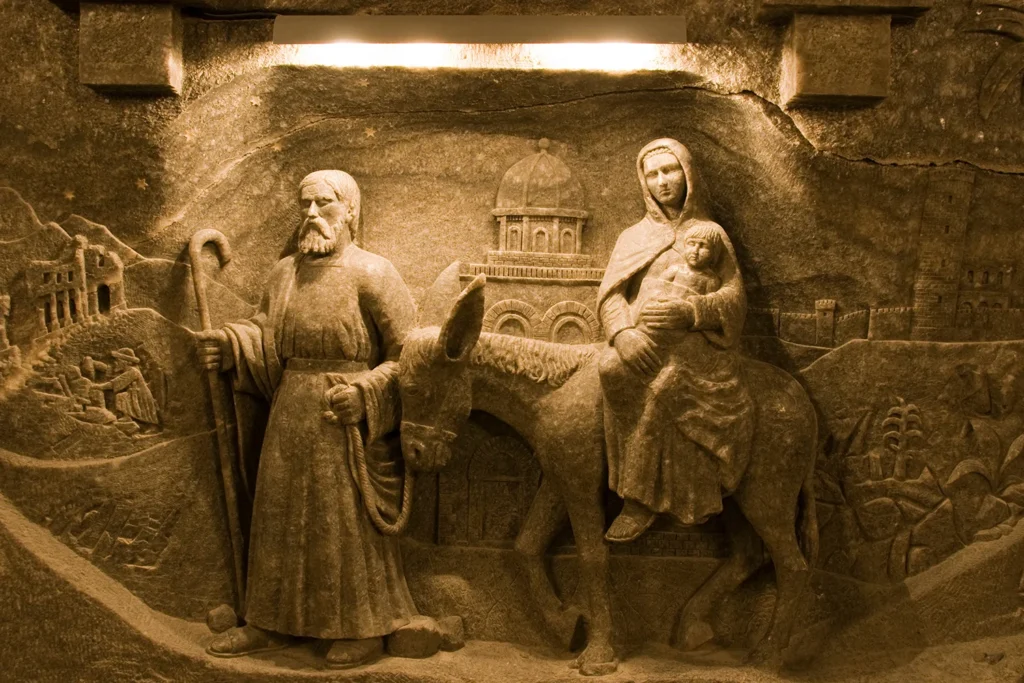
The round chamber of Nicolaus Copernicus, formed after the extraction of green salt, is recognizable by the statue of the astronomer carved from a block of salt in the center of the room. Another chamber created after the removal of green salt is the Weimar Chamber, famous for its romantic light and sound show that enchants visitors. Key features of this underground hall include statues of the Mine Guardian, the benevolent spirit of the mine, and the German poet Johann von Goethe, one of the mine’s earliest visitors.
Other Salt Chambers in Wieliczka
There is an abundance of salt chambers in Wieliczka, each possessing something unique. It’s impossible to describe them all, but a few deserve a brief introduction:
- Warsaw Chamber – Created in the late 19th and early 20th century after the excavation of pantry salt, this chamber is notable for its vast size and is now primarily used for concerts, ceremonies, and balls.
- Izabela Chamber – Formed through the mining of shaft salt, this chamber, with its distinct geological structure, showcases the impact of mountain movements on the underground deposits in Wieliczka.
- Sielec Chamber – The main attraction here is the reconstructed equipment once used for horizontal salt transport. Visitors can see special sleds and old carts that were used to move the salt.
- Kazimierz III Chamber – Named after King Kazimierz the Great, the Polish monarch who initiated the first Statute of the Kraków Saltworks. A bust of the ruler was unveiled here to commemorate the 600th anniversary of this event.
St. Kinga’s Chapel
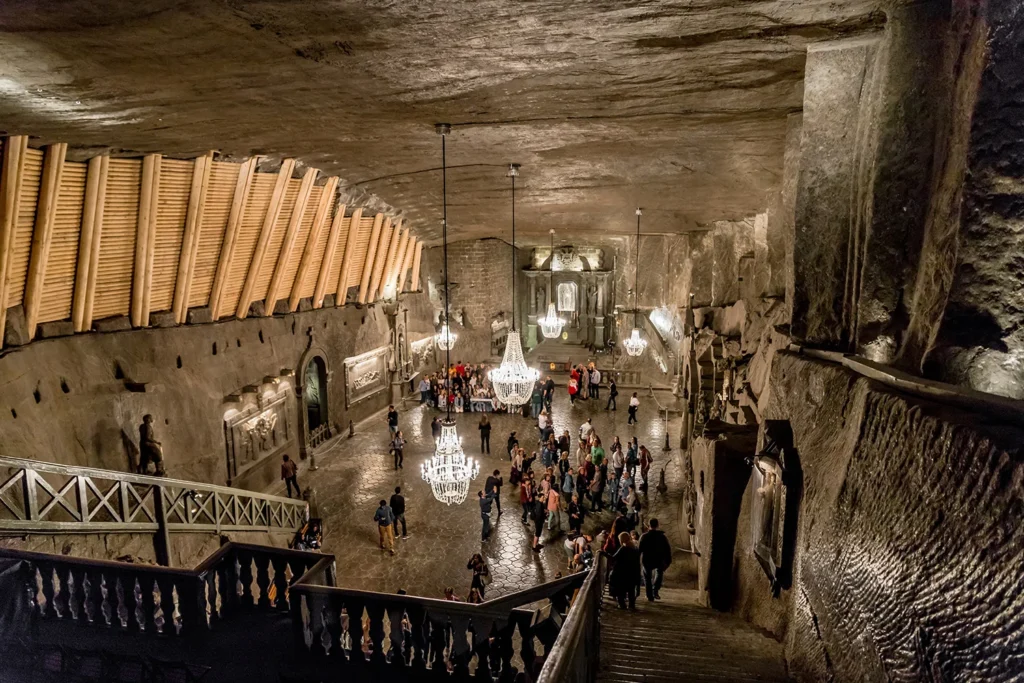
One of the most remarkable attractions of the Wieliczka Salt Mine is the extraordinary chapel located over 100 meters underground. St. Kinga’s Chapel occupies a chamber created in 1896, where a large block of green salt once stood. However, it took nearly 70 years of work to transform the empty space into the magnificent underground sanctuary it is today. Anyone who has visited the chapel will tell you it was worth the wait. The salt block floor, crystal chandeliers made from salt, artworks, and reliefs are just a few of the surprising details in this space. The salt-crafted elements, such as the altar table, Nativity scene, and the statue of St. Kinga, are particularly impressive. And speaking of sculptures, the salt statue of Pope John Paul II is another highlight, as it’s the only papal representation carved in salt in the world.
GOOD TO KNOW: St. Kinga’s Chapel is by far the most famous of Wieliczka’s underground chapels, but there are several others on the tour route. The oldest is the Chapel of St. Anthony, and the Chapel of St. John is known for its wooden furnishings.
Crystal Caves
The greatest natural phenomenon within the Wieliczka Salt Mine is undoubtedly the so-called Crystal Caves. These underground hollow spaces resemble rooms filled with transparent rock salt, taking on regular, crystal-like shapes. The common mineral in such a form can easily be mistaken for actual crystals or precious stones. Both the Upper and Lower Crystal Caves were discovered in the 19th century, and in 2000 they were designated as a protected nature reserve for inanimate nature.
Now for the bad news. During a tour of the mine, it’s not possible to enter any of the crystal caves. The crystals are so delicate that even slight changes in humidity or temperature inside the chambers could damage them. Luckily, a glimpse of the crystals adorning the walls of the chambers can be seen in display cases at the Kraków Saltworks Museum.
Kraków Saltworks Museum (Muzeum Żup Krakowskich)
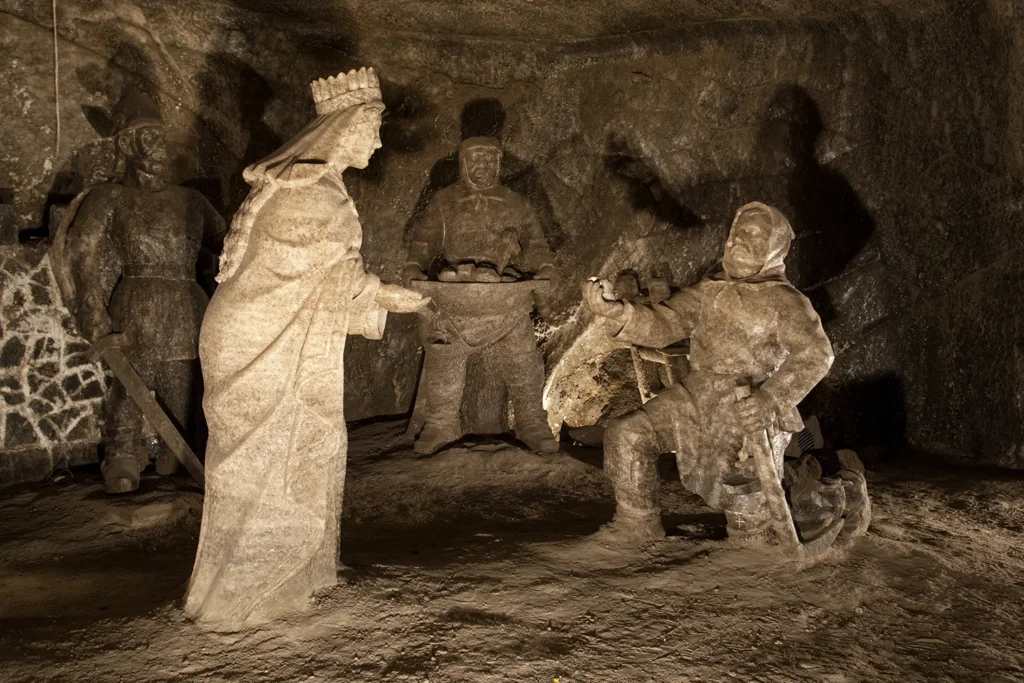
What’s the story behind the “żupy”? A “żupa” is simply an old term for a salt mine, and the name Żupy Krakowskie refers to the salt mines in Wieliczka and Bochnia, along with their saltworks. The Kraków Saltworks Museum, located underground in Wieliczka, is dedicated to exhibits related to these historic sites. The museum’s collection includes remarkable items like salt crystals of unusual colors and shapes, a model of a prehistoric saltworks, and even original paintings by Jan Matejko. However, the most prized item in the museum is another piece altogether.
Among the museum’s most valuable objects is the Silver Horn of the Miners’ Brotherhood, a symbol of the mine’s wealth. It competes for the title of the museum’s most significant artifact with the horse-powered wooden capstans, ancient machines that once operated with the strength of horses. The museum houses a collection of these wooden capstans, with the 16-meter Polish Capstan being the oldest and largest surviving one of its kind.
The Brine Graduation Tower
Another unique attraction at the Wieliczka Salt Mine is the brine graduation tower, located on the surface in St. Kinga’s Park and covering an area of 3,200 m². Why should you visit this attraction? Inside the tower, brine water trickles drop by drop down slender blackthorn branches, creating a mist filled with salt particles. This environment provides a natural remedy for fatigue, stress, and lack of energy.
Spending 30 minutes in the brine tower also strengthens the immune system, helps cleanse the respiratory tract, and combats skin problems. Access to the tower requires an additional fee, but trust me, it’s a small price to pay for such a relaxing way to end your visit to Wieliczka.
Which route to choose?
If you’re interested in exploring deep underground, you have two routes to choose from. The more popular one is the Tourist Route, which takes you down three levels and allows you to see the most beautiful corners of the salt labyrinth. You’ll pass through underground chambers and chapels, and see saline lakes and salt sculptures. You’ll also get an up-close look at old mining tools and learn about different methods of salt transportation. In short, it’s like a therapeutic walk combined with stunning landscapes and a wealth of knowledge. This route also includes access to the Kraków Saltworks Museum, which is worth visiting after completing the Tourist Route.
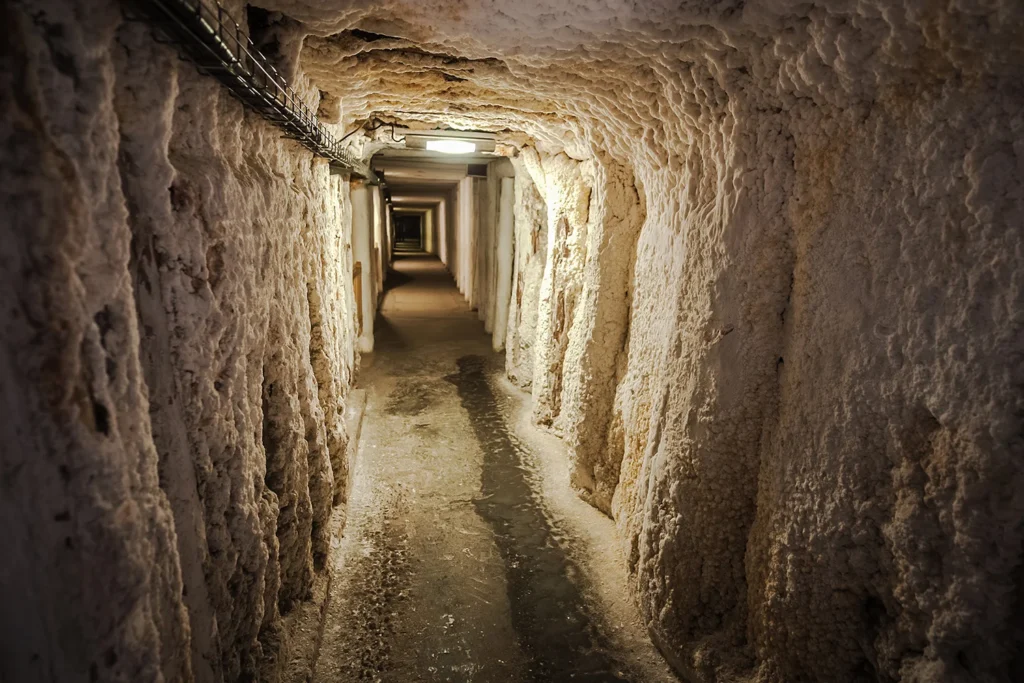
But if adventure speaks to your soul, the Miner’s Route might be more appealing. This is an extraordinary chance to step into the role of a miner, even if just for a short while. After a brief training session, you’ll don a special jumpsuit, put on a headlamp, and take mining tools in hand as you descend into a completely different, rawer part of the mine. On this rustic route, you’re likely to get a little dirty and tired, but boredom is out of the question. Not only will you learn many details about a miner’s life, but you’ll also face tasks similar to those a miner handles daily.
Visiting the Wieliczka Salt Mine
What should you remember before heading to the mine? First of all, proper attire is key. Regardless of external weather conditions, the underground temperature doesn’t exceed 20°C, so don’t be fooled by summer heat—along with comfortable shoes, bring a sweatshirt and long pants. It’s also important to note that any descent into the mine is only possible with a guide, so wandering alone through the salt labyrinth is just a dream.
It’s best to buy your tickets online, for example through the GetYourGuide platform. There, you’ll find not only entrance tickets but also tour options with transport from Krakow or full-day tours combining Wieliczka and Auschwitz.
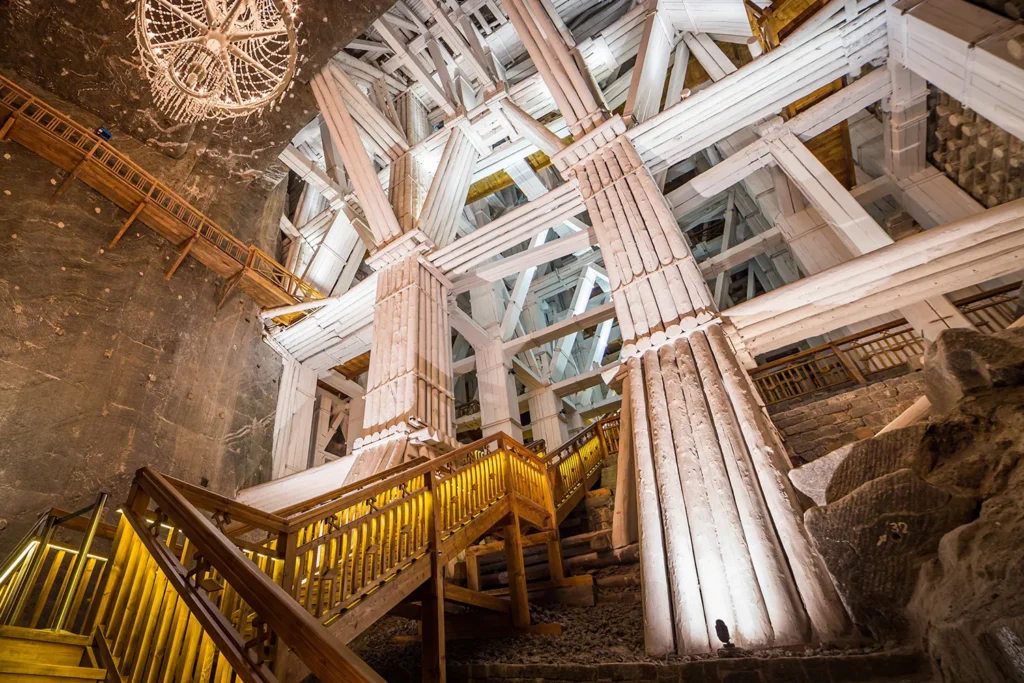
During your visit to the mine, it’s also worth taking advantage of the underground health resort, which harnesses the therapeutic properties of the underground microclimate to treat respiratory diseases. The center has been in operation since 1997 and is located in the Teodor Wessel chamber, at a depth of 135 meters. Meanwhile, the Witold Budryk chamber, carved out where pantry salt once lay, offers the opportunity to satisfy your hunger 125 meters underground. In the salt labyrinth, you can also purchase souvenir salt figurines, and if you want to spend more time exploring Wieliczka’s attractions, you can even try spending the night underground by booking accommodation in the Słowacki chamber.
Practical information
- It is best to purchase tickets for the Wieliczka Salt Mine in advance. This way, you can avoid standing in long lines and reduce the risk of tickets being sold out.
- Address: Daniłowicza 10, 32-020 Wieliczka, Poland
- Buy tickets on GetYourGuide